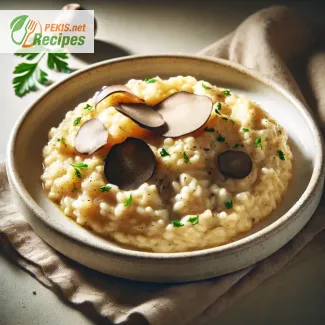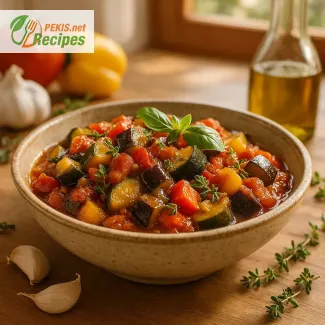
Risotto with Mushrooms and Truffles is a true celebration of refined, earthy flavors and Italian culinary artistry. This luxurious dish combines the rich creamy texture of perfectly cooked Arborio rice with the robust, umami depth of mushrooms and the distinctive, aromatic allure of truffles. Ideal for an intimate dinner or a sophisticated gathering, this risotto delivers a gourmet experience that transforms any meal into an elegant affair.
At the heart of this recipe lies the delicate balance of flavor and texture. The mushrooms – whether porcini, shiitake, or cremini – add a hearty, slightly meaty quality to the risotto, enhancing its richness and depth. The truffles, on the other hand, contribute an incomparable touch of luxury and fragrance, elevating this simple risotto to a dish that captivates with every bite. When prepared properly, each spoonful offers the perfect blend of creamy rice, earthy mushroom notes, and the unmistakable essence of truffle, creating a dish that satisfies both the palate and the senses.
Cooking risotto requires a gentle touch and patience, as each ladleful of hot broth is gradually absorbed by the rice, releasing its natural starches and creating a silky, smooth consistency. As the mushrooms cook alongside the rice, their flavors meld beautifully into each grain, intensifying the dish’s flavor profile. This method, though requiring a bit of time, ensures that each bite of the risotto is rich, creamy, and full of flavor, while the addition of truffle oil or fresh truffle shavings just before serving adds the finishing touch to a perfectly indulgent meal.
Risotto with Mushrooms and Truffles isn’t just a dish; it’s an experience. Its warm, inviting flavors make it versatile for various occasions, from romantic dinners to festive celebrations. Paired with a glass of Italian white wine, such as Chardonnay or Pinot Grigio, this risotto truly shines, with the wine’s acidity balancing the dish’s richness and enhancing the flavors of the mushrooms and truffles.
One of the most appealing aspects of this risotto is its elegance and simplicity. While the flavors are deep and robust, they never overwhelm. The creamy texture and subtle truffle notes create a harmonious dish that satisfies both the soul and the senses, reflecting the essence of Italian cuisine – where quality ingredients and traditional cooking techniques allow each component to shine.
For those who appreciate gourmet flavors and the charm of Italian dishes, Risotto with Mushrooms and Truffles is an exceptional choice. This recipe showcases how a few high-quality ingredients, treated with care, can come together to create a meal that’s luxurious, satisfying, and unforgettable. Whether you serve it as a standalone entrée or as part of a thoughtfully curated menu, this risotto leaves a lasting impression with its refined, earthy elegance.
Whether you’re a seasoned chef or a home cook looking to impress, Risotto with Mushrooms and Truffles offers an unparalleled dining experience that embodies the best of Italian culinary traditions. Its creamy, deeply flavored character invites you to indulge in each bite, making it the perfect dish for any occasion that calls for a touch of elegance and indulgence.
- Heat the Olive Oil and Butter: In a large skillet or saucepan, heat the olive oil and butter over medium heat until melted.
- Cook the Onion: Add the finely chopped onion and cook, stirring frequently, until softened and translucent, approximately 5 minutes.
- Toast the Rice: Add the Arborio rice to the pan, stirring continuously until the rice is lightly toasted and coated in oil, about 2-3 minutes.
- Deglaze with White Wine: Pour in the white wine and stir until the wine has mostly evaporated, allowing the rice to absorb its flavor.
- Cook with Broth: Add a ladleful of hot vegetable broth to the rice, stirring continuously until most of the liquid is absorbed. Continue adding broth, one ladle at a time, stirring constantly and waiting for each addition to be absorbed before adding more. This process will take about 20 minutes.
- Add Mushrooms: When the rice is about halfway cooked, stir in the sliced mushrooms. Continue adding broth and stirring until the rice is creamy and the mushrooms are tender.
- Finish with Truffle Oil and Parmesan: Once the risotto has reached a creamy consistency and the rice is al dente, remove the pan from heat. Stir in the truffle oil and grated Parmesan cheese until well incorporated.
- Season: Add salt and freshly ground black pepper to taste, adjusting as needed.
- Garnish and Serve: Serve the risotto immediately, garnished with fresh parsley and, if desired, thin slices of fresh truffle.
Tips for Enhancing and Customizing the Recipe for Risotto with Mushrooms and Truffles
Crafting the perfect Risotto with Mushrooms and Truffles is a delightful journey in balancing flavor and texture. This luxurious dish can be adjusted and improved in numerous ways, allowing you to tailor it for specific tastes, dietary needs, or even seasonal preferences. Here are some detailed tips to help you elevate each aspect of this dish, from the selection of mushrooms to the careful incorporation of truffle flavor. Each recommendation is designed to refine this earthy, elegant recipe and ensure it impresses every time.
1. Choosing the Right Rice for Ideal Texture
The foundation of any risotto is the rice, which determines both the texture and creaminess of the final dish:
- Arborio Rice: A classic choice due to its high starch content, which creates the rich, creamy texture characteristic of risotto.
- Carnaroli Rice: Known as the "king of rice" for risotto, Carnaroli retains its texture even after extended cooking, making it slightly firmer and providing a creamier end result.
- Vialone Nano: A plump, absorbent variety from the Veneto region, Vialone Nano results in a silkier texture and is excellent if you’re looking for a smoother risotto.
Each type brings unique characteristics that can impact the overall texture of the risotto, so experimenting with these can add a new depth to your dish.
2. Selecting Mushroom Varieties for Deeper Flavor
Mushrooms provide the risotto with its earthy, umami base, and experimenting with different types can further enhance the flavor complexity:
- Porcini: These mushrooms have a robust, nutty flavor that complements truffle perfectly. They add a deep, earthy tone that enriches the overall taste.
- Shiitake: Known for their smoky, savory taste, shiitakes add a distinct depth to risotto and balance the truffle’s aromatic profile.
- Cremini or Brown Mushrooms: Milder in flavor, these mushrooms bring a pleasant, meaty texture and round out the dish with a more subtle taste.
Adding dried mushrooms can intensify the flavor. Simply rehydrate them in warm water and use the soaking liquid as part of your broth for a deeper, earthy essence.
3. Enhancing Truffle Flavor
Truffles bring a unique, luxurious aroma to the risotto, but to achieve the right balance, consider these methods:
- Layering Truffle Oil: Add a small amount of truffle oil early in the cooking process, along with a final drizzle before serving. This layering technique enhances the truffle’s aroma throughout the dish.
- Fresh Truffle Shavings: If fresh truffles are available, thinly shaving them over the risotto just before serving adds an extra layer of richness and visual appeal.
- Truffle Salt: Substitute regular salt with truffle salt to subtly infuse truffle essence into each bite, adding another dimension without overpowering the dish.
Truffles have a potent aroma, so use them sparingly to avoid masking the delicate flavors of the mushrooms and rice.
4. Adjusting for Dietary Preferences
Whether you’re cooking for dietary restrictions or looking to create a lighter version of this risotto, it’s highly adaptable:
- Dairy-Free Option: Substitute the butter with additional olive oil or a plant-based alternative. Nutritional yeast provides a savory flavor, making it a suitable replacement for Parmesan.
- Vegan Option: Use vegetable broth and follow the dairy-free adjustments. For additional texture, add extra mushrooms or diced vegetables, such as asparagus or peas.
- Low-Sodium Version: Opt for low-sodium broth, as Parmesan and truffle salt can naturally add saltiness. Reducing added salt can enhance the other flavors and make for a more balanced dish.
5. Experimenting with Broth Types
The choice of broth can have a significant impact on the flavor of the risotto:
- Vegetable Broth: Traditional and ideal for letting mushroom and truffle flavors take center stage.
- Chicken Broth: Adds a richer, more rounded flavor base, deepening the body of the risotto.
- Mushroom Broth: Intensifies the earthy undertones and enhances the natural flavors of the mushrooms.
Each broth variety allows you to tailor the risotto’s depth, flavor, and richness according to your preference.
6. Adding Ingredients for Complexity
For those who enjoy experimenting with flavors, consider these ingredients to add richness and contrast:
- Truffle Butter: Incorporating a small amount of truffle butter instead of regular butter in the final stages provides both a creamy texture and a subtle truffle flavor.
- Fresh Herbs: A touch of fresh thyme or rosemary can add complexity without overwhelming the truffle aroma.
- Garlic: Adding a minced garlic clove when cooking the onion creates a savory base without overpowering the main flavors.
7. Tips for Achieving the Perfect Risotto Texture
The right texture for risotto is creamy but not mushy, with each grain retaining a slight bite:
- Consistent Stirring: Stirring releases starch from the rice, creating the creamy consistency. However, gentle stirring prevents breaking the grains.
- Gradual Broth Addition: Adding broth one ladle at a time allows the rice to absorb each addition fully, maintaining a creamy consistency without overcooking.
- Resting Period: Letting the risotto rest for a minute before serving helps the flavors meld and allows any remaining liquid to be absorbed.
Making Healthier Ingredient Choices
While risotto is often viewed as indulgent, slight adjustments can improve its nutritional value:
- Whole-Grain Arborio Rice: Whole-grain Arborio rice provides more fiber and nutrients than traditional white Arborio, which can benefit digestion and satiety.
- Plant-Based Cheese Alternatives: Use nutritional yeast or dairy-free Parmesan to lower cholesterol and saturated fat without sacrificing flavor.
- Adding Vegetables: Stirring in vegetables such as spinach, peas, or asparagus not only enhances flavor but also increases the vitamin and fiber content.
Pairing Suggestions for a Refined Dining Experience
Choosing the right accompaniments can elevate this risotto to a full fine dining experience:
- Wine Pairing: A Chardonnay or Pinot Noir complements the creamy, earthy flavors well, with enough acidity to balance the dish’s richness.
- Side Dishes: A light salad with arugula and lemon vinaigrette or roasted asparagus provides a refreshing contrast, brightening the palate.
Storing and Reheating Tips
While risotto is best enjoyed fresh, any leftovers can still be delicious if reheated properly:
- Refrigerate in an Airtight Container: Store any leftover risotto in a tightly sealed container in the fridge for up to two days.
- Reheat with Extra Broth: When reheating, add a splash of broth to restore the creamy consistency and stir gently over low heat.
- Transform into Arancini: Cold risotto can be shaped into balls, coated in breadcrumbs, and fried to make arancini, adding a crispy texture to the creamy interior.
These tips provide various ways to enhance the flavors, textures, and presentation of Risotto with Mushrooms and Truffles, creating a memorable and gourmet experience each time. By experimenting with ingredients, cooking techniques, and presentation, this classic dish can be adapted and elevated to match any culinary occasion, providing a truly luxurious and satisfying meal.
- Contains dairy (butter and Parmesan cheese).
- Gluten-free if made with gluten-free broth.
To make this recipe dairy-free, substitute butter with a plant-based alternative and omit Parmesan cheese or use a dairy-free version.
- Vitamin B1 (Thiamine): Supports energy metabolism and nerve function.
- Vitamin B2 (Riboflavin): Important for cellular growth and metabolism.
- Vitamin D: Mushrooms are a source of vitamin D, which is essential for bone health.
- Iron: Helps in oxygen transport and reduces fatigue.
- Potassium: Supports heart health and fluid balance.
- Ergothioneine (from mushrooms): An antioxidant that protects cells from damage and may reduce inflammation.
- Glutathione: Supports immune function and may aid in detoxification.
- Vitamin E: Found in truffle oil, it protects cells and supports skin health.





